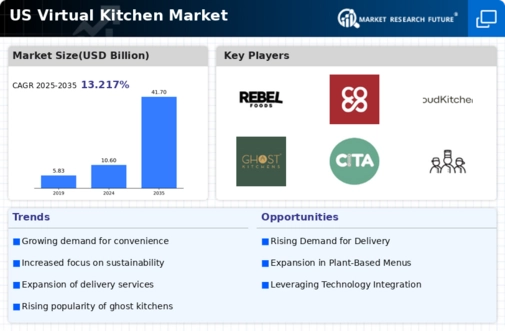Rising Health Consciousness
The virtual kitchen market is also being shaped by a rising health consciousness among consumers. As individuals become more aware of the nutritional value of their food, there is a growing demand for healthier meal options. This trend is prompting virtual kitchens to innovate and offer menus that cater to health-oriented consumers. In 2025, it is projected that the market for healthy meal delivery services will account for approximately 25% of the overall meal delivery market in the US. The virtual kitchen market is responding by incorporating fresh, organic ingredients and providing transparent nutritional information. This focus on health not only attracts a broader customer base but also encourages loyalty among health-conscious consumers, thereby enhancing the competitive landscape of the industry.
Expansion of Online Food Ordering
The virtual kitchen market is significantly influenced by the expansion of online food ordering platforms. With the proliferation of smartphones and internet access, consumers are increasingly turning to digital solutions for their dining needs. In 2025, it is estimated that over 60% of consumers in the US will prefer ordering food online rather than dining out. This shift is reshaping the virtual kitchen market, as businesses adapt to meet the growing demand for online ordering. The convenience of browsing menus, placing orders, and tracking deliveries has become a key driver of consumer behavior. As a result, virtual kitchens are likely to enhance their online presence and optimize their delivery logistics to capture this expanding market segment.
Increasing Demand for Convenience
The virtual kitchen market is experiencing a notable surge in demand for convenience among consumers. As lifestyles become increasingly hectic, individuals are seeking quick and easy meal solutions. This trend is reflected in the growing popularity of meal delivery services, which have expanded their offerings to include a variety of cuisines. In 2025, the market for meal delivery services in the US is projected to reach approximately $30 billion, indicating a robust growth trajectory. The virtual kitchen market is well-positioned to capitalize on this demand, as it allows for streamlined operations and efficient meal preparation, catering to the needs of busy consumers. This shift towards convenience is likely to drive innovation and competition within the industry, as companies strive to meet consumer expectations for speed and quality.
Sustainability and Eco-Friendly Practices
Sustainability is becoming a pivotal concern within the virtual kitchen market. As consumers grow more environmentally conscious, there is a rising expectation for businesses to adopt eco-friendly practices. This trend is influencing the sourcing of ingredients, packaging materials, and waste management strategies within the virtual kitchen market. In 2025, it is estimated that 40% of consumers will prioritize sustainability when choosing food services. Virtual kitchens are responding by implementing sustainable sourcing practices, reducing plastic waste, and promoting plant-based menu options. This commitment to sustainability not only aligns with consumer values but also enhances brand reputation, potentially attracting a loyal customer base that prioritizes environmental responsibility.
Technological Advancements in Food Preparation
Technological advancements are playing a crucial role in the evolution of the virtual kitchen market. Innovations in food preparation and cooking techniques are enabling virtual kitchens to enhance efficiency and reduce operational costs. For instance, the integration of automated cooking equipment and smart kitchen appliances is streamlining food production processes. In 2025, it is anticipated that the adoption of such technologies will increase by over 30% within the virtual kitchen market. This shift not only improves the quality and consistency of meals but also allows for faster service, meeting the demands of an increasingly impatient consumer base. As technology continues to evolve, virtual kitchens are likely to leverage these advancements to gain a competitive edge.























Leave a Comment